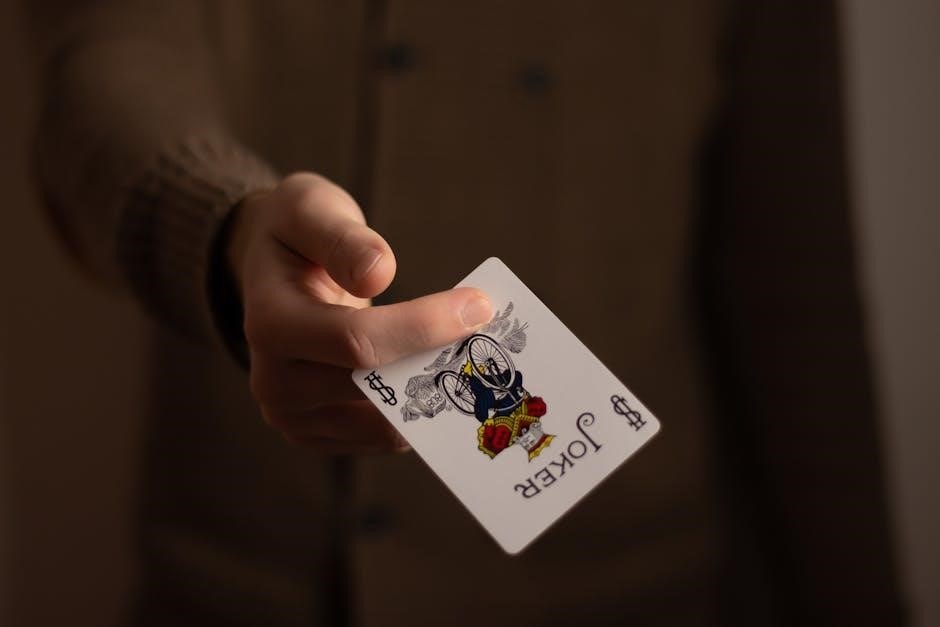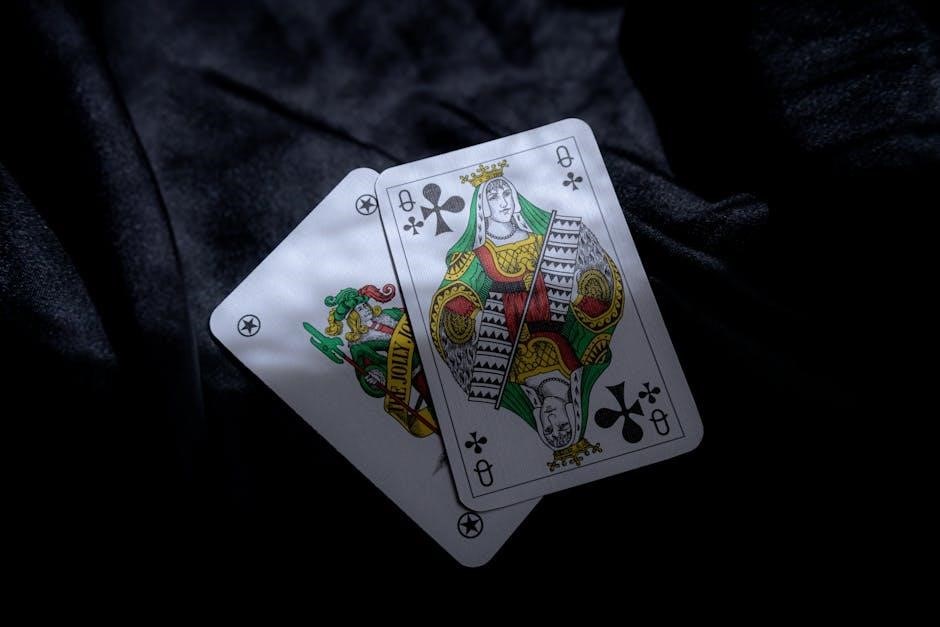Pit is a classic party card game where players aim to corner the market on commodities like Flax‚ Corn‚ and Wheat. Designed for 3 to 8 players‚ it combines strategic trading cards with excitement‚ making it perfect for family game nights or competitive play. The game starts with a bell ring‚ and players must collect sets to win. The Bull and Bear cards add twists‚ penalizing or aiding players. With simple rules and fast-paced action‚ Pit is a timeless favorite for all ages.
Overview of Pit
Pit is a lively party card game designed for 3 to 8 players aged 7 and above. Players aim to corner the market on commodities like Flax‚ Corn‚ and Wheat by collecting matching cards. The game is known for its fast-paced trading and strategic use of special cards‚ such as the Bull and Bear‚ which add twists to the gameplay. This makes Pit a timeless favorite for family game nights or competitive play.
Objective of the Game
The primary objective in Pit is to corner the market by collecting nine cards of the same commodity‚ such as Flax‚ Corn‚ or Wheat. Players achieve this by trading cards with others‚ aiming to be the first to complete a full set. The game rewards strategic trading and quick thinking‚ as players must negotiate and exchange cards efficiently. The goal is to accumulate all nine cards of one commodity‚ which allows the player to “corner the market” and win the game. This objective drives the fast-paced and competitive nature of Pit‚ making it a thrilling experience for participants.
Number of Players
Pit is designed for 3 to 8 players‚ making it an ideal game for small to medium-sized groups. The game is most dynamic with 4 to 7 players‚ as it allows for lively trading interactions. With fewer than 3 players‚ the game loses its competitive edge‚ while more than 8 players can make trading too chaotic. The deck includes 74 cards‚ and the number of cards dealt to each player varies based on the total number of participants. For example‚ in a 4-6 player game‚ each player receives 9 cards‚ while in a 7-10 player game‚ they receive 8 cards. This flexibility ensures balanced gameplay across different group sizes.
Materials Needed
To play Pit‚ you will need a few essential items. The game requires a deck of 74 playing cards‚ which includes cards for seven different commodities (Flax‚ Corn‚ Barley‚ Hay‚ Rye‚ Wheat‚ and Oats) and special cards like the Bull and Bear. A silver playing bell is also necessary to signal the start of trading and key moments in the game. Additionally‚ the game instructions are provided to guide players through setup‚ trading‚ and scoring. While not required‚ items like scorepads and pens can be useful for tracking points across multiple rounds. These materials ensure smooth and enjoyable gameplay for all participants.
Audience and Age Range
Pit is a family-friendly game suitable for players aged 7 and above‚ making it an excellent choice for both children and adults. Its simple yet engaging gameplay appeals to a wide audience‚ fostering social interaction and strategic thinking. Families can enjoy it together‚ while older players can appreciate its competitive nature. The game’s lively trading mechanics and quick rounds ensure it remains entertaining for all age groups. Pit is ideal for gatherings‚ parties‚ or casual game nights‚ providing fun and challenge for everyone involved. Its accessibility and age-appropriate design make it a timeless favorite across generations.

Understanding the Cards
The game features 74 cards‚ including commodities like Flax‚ Corn‚ and Wheat. Special cards‚ such as Bull and Bear‚ add unique mechanics to the trading experience.
Commodities in the Game
The game features seven main commodities: Flax‚ Corn‚ Barley‚ Hay‚ Rye‚ Wheat‚ and Oats. Each commodity has nine cards‚ totaling 63 cards. Players aim to collect all nine cards of one commodity to “corner the market.” These commodities are central to the game’s trading mechanics‚ with each card representing a unit of a specific commodity. The goal is to accumulate a complete set of any one commodity to win. The commodities vary in value‚ with Wheat being the most valuable. Understanding their significance is key to mastering the game’s trading dynamics and strategies.
The Role of the Bull Card
The Bull card acts as a wild card in the game‚ allowing players to complete a set of any commodity. If a player holds the Bull card and collects eight cards of the same commodity‚ they can use the Bull card as the ninth to “corner the market.” This strategic advantage enables players to score points by completing a full set. However‚ the Bull card can also be a penalty card in certain situations‚ depending on the game’s rules. Its dual role adds excitement and unpredictability to the gameplay‚ making it a crucial card to manage effectively during trades.
The Role of the Bear Card
The Bear card introduces a strategic risk in the game‚ as it carries a penalty for the player holding it. If a player has the Bear card when the game ends or when another player corners the market‚ they lose 20 points. Additionally‚ if a player completes a full set of a commodity but still holds the Bear card‚ they incur another 20-point penalty. This makes it crucial for players to strategically trade and discard the Bear card before completing their set. Managing the Bear card effectively is key to avoiding unnecessary point losses and maintaining a competitive edge in the game.
Penalties Associated with the Bear Card
Holding the Bear card at the end of the game results in a 20-point penalty. Additionally‚ if a player completes a full set of a commodity but still has the Bear card‚ they face another 20-point deduction. These penalties emphasize the importance of strategically trading and discarding the Bear card before completing a set. Players must balance the risk of holding the Bear card against the potential benefits of completing their collection quickly. Proper management of the Bear card is essential to avoid significant point losses and maintain a competitive position in the game.

Setting Up the Game
The game begins by shuffling the deck and dealing cards based on the number of players. The dealer rings the bell to signal the start‚ initiating trading.

Dealing the Cards
Dealing the cards is the first step in setting up the game. The number of cards each player receives depends on the total number of players. For 4-6 players‚ each player is dealt 9 cards; If there are 7-10 players‚ each player gets 8 cards. For 11-12 players‚ the number of cards per player is reduced to 7. The deck is shuffled‚ and cards are distributed evenly to ensure fairness. The remaining cards are placed face down in a draw pile. The dealer then rings the bell to signal the start of trading‚ and the game officially begins.
Number of Cards per Player
The number of cards each player receives varies based on the total number of participants. In a game with 4-6 players‚ each player is dealt 9 cards. If the game includes 7-10 players‚ each player receives 8 cards. For larger groups of 11-12 players‚ each player is given 7 cards. This adjustment ensures the game remains balanced and engaging regardless of the number of participants. The deck is divided evenly among players‚ and any remaining cards are set aside. This system guarantees fair distribution and maintains the game’s dynamic nature across different group sizes.
Variations Based on Player Count

The game adapts to different player counts by adjusting the number of commodities used. With 3 players‚ only 3 suits are included‚ while 4 players use 4 suits. When 7 players join‚ the entire deck is utilized‚ enhancing the game’s complexity. For larger groups beyond 7‚ creative variations can be implemented‚ though the standard rules are designed for up to 8 players. This flexibility ensures the game remains engaging and balanced‚ regardless of the number of participants‚ making it suitable for both small gatherings and larger parties. The dynamic nature of Pit allows it to scale seamlessly across various group sizes.

Gameplay Mechanics
The game begins with a bell ring‚ initiating frantic trading. Players exchange cards to collect a full set of one commodity‚ using the Bull card strategically to corner the market and gain an advantage‚ while avoiding penalties from the Bear card to win the round.
Starting the Game
The dealer rings the bell to begin‚ signaling players to start trading. Each player receives a set number of cards based on the total number of players (e.g.‚ 9 cards for 4-6 players). Players must collect a full set of one commodity to win. Trading begins immediately‚ with players calling out the number of cards they wish to trade. The Bull card can act as a wild card to complete a set‚ while the Bear card imposes penalties if held during the final call. The game moves quickly‚ requiring strategic trading and quick thinking to corner the market before others do.
Trading Cards
Trading is the core of Pit‚ where players negotiate and exchange cards to complete sets. Players call out the number of cards they wish to trade‚ and only those with matching numbers can participate. For example‚ if a player calls “two‚” others with two cards of the same commodity can trade. The goal is to collect nine cards of one commodity. The Bear card penalizes players if held during the final call‚ while the Bull card can act as a wild card to complete a set. Strategic trading and quick thinking are essential to outmaneuver opponents and corner the market first.
Cornering the Market
Cornering the market in Pit means collecting all nine cards of a single commodity‚ such as Wheat or Corn. This is achieved through strategic trading and quick decision-making. When a player completes a full set‚ they “corner the market” and win the round. The Bull card can assist by acting as a wild card to complete the set‚ while the Bear card penalizes players if held during the final call. The goal is to be the first to gather all nine cards of one commodity‚ showcasing mastery of the trading dynamics and securing victory. Speed and strategy are key to success.
Using the Bull Card Strategically
The Bull Card is a powerful tool in Pit‚ acting as a wild card to help complete a set of nine cards in a commodity. Use it strategically by holding it until you’re close to completing a set‚ then play it to secure the ninth card. Ringing the bell and calling “Wild Pit” allows you to score points based on the commodity’s value. However‚ avoid holding the Bull Card unnecessarily‚ as penalties may apply if you’re caught with it at the end. Timing its use wisely can turn the game in your favor‚ making it a crucial part of your strategy.

Winning the Game
To win‚ a player must corner the market by collecting nine cards of the same commodity. The game ends immediately when this is achieved‚ and the player scores points based on the commodity’s value.
Completing a Full Set
Completing a full set in Pit involves gathering nine cards of the same commodity‚ such as Wheat‚ Corn‚ or Flax. This is achieved through strategic trading with other players. When a player collects all nine cards of one commodity‚ they must immediately ring the bell to signal their victory. The game ends‚ and the player scores points based on the value of the commodity they cornered. The goal is to be the first to achieve this‚ as the game concludes instantly upon completing the set‚ making it a thrilling race to dominate the market.

Scoring Points
Scoring points in Pit is based on the value of the commodity you corner. Each commodity has a specific point value‚ with Wheat being the highest at 100 points and Flax the lowest at 40; When you complete a full set of nine cards of a commodity‚ you score points equal to that commodity’s value. If you hold the Bull card when completing the set‚ it acts as a wild card‚ boosting your score. Conversely‚ if you hold the Bear card‚ you lose 20 points. The game ends immediately upon completing a set‚ and the points are tallied to determine the winner.
End of the Game
The game concludes when a player successfully corners the market by completing a full set of nine cards of the same commodity. Once this happens‚ the game ends immediately‚ and no further trading is allowed. The player with the completed set scores points based on the commodity’s value. If the Bear card is in their hand‚ a 20-point penalty is applied. The player with the highest score after completing the set is declared the winner. In competitive play‚ multiple rounds may be played‚ with an overall target score (e.g.‚ 350 points) determining the ultimate champion.

Advanced Strategies
Mastering trading dynamics and managing the Bear card’s risks are key. Optimize trades by focusing on high-value commodities and strategically using the Bull card to corner markets effectively.

Understanding Trading Dynamics
Trading dynamics in Pit revolve around strategic offering and requesting of specific numbers of commodity cards. Players must call out the number of cards they wish to trade‚ matching with others who have the same number. This creates a fast-paced‚ chaotic environment where quick thinking and sharp instincts are essential. Effective traders must balance risk and reward‚ knowing when to hold onto valuable cards and when to trade aggressively. The ability to anticipate opponents’ moves and adapt to the flow of the game significantly enhances chances of success. Mastering these dynamics is crucial for cornering the market and winning.
Managing the Bear Card Risk
The Bear card introduces a significant penalty risk in Pit‚ deducting 20 points if held at the end of the game or when completing a commodity set. To mitigate this risk‚ players must strategically discard the Bear card early or use it to disrupt opponents. If you acquire the Bear card‚ avoid holding it until the game’s end by trading it quickly or using it to block others from completing their sets. Being aware of the Bear card’s presence in play allows you to anticipate penalties and adjust your strategy. Effective management of this card is crucial for maintaining a competitive edge.
Optimizing Card Trades
Optimizing card trades is essential for success in Pit. Knowing when to trade and what to offer can make a significant difference. Focus on trading cards that help you complete sets. Pay attention to other players’ collections to make informed offers. Trading early can help you get rid of unwanted cards‚ while strategic trades later in the game can help you complete your sets. Proper timing and strategic offers are key to optimizing your trades and winning the game.
Pit is a timeless‚ energetic card game perfect for family game nights or competitive play among 3 to 8 players‚ blending strategy with excitement through fast-paced trading and market cornering.
Final Thoughts
Pit is a thrilling and dynamic card game that combines luck‚ strategy‚ and social interaction‚ making it a standout choice for family gatherings or competitive play. Its simple yet engaging mechanics allow players of all ages to enjoy the excitement of trading and cornering markets‚ with the Bull and Bear cards adding unexpected twists. The game’s ability to accommodate a wide range of players ensures inclusivity and fun for everyone involved. Whether you’re seeking a lively party game or a strategic challenge‚ Pit delivers an unforgettable experience that keeps players coming back for more. Give it a try and see why it’s a timeless classic!
Additional Resources
For further learning and mastering Pit‚ explore these resources:
– Video tutorials on Amazon provide step-by-step guides for beginners.
– Official Pit card game websites offer detailed rules and strategies.
– Join card game forums to discuss tips and variations with experienced players.
– Check out YouTube channels for gameplay demonstrations and competitive plays.
These resources will enhance your understanding and help you refine your trading skills for a more enjoyable experience.